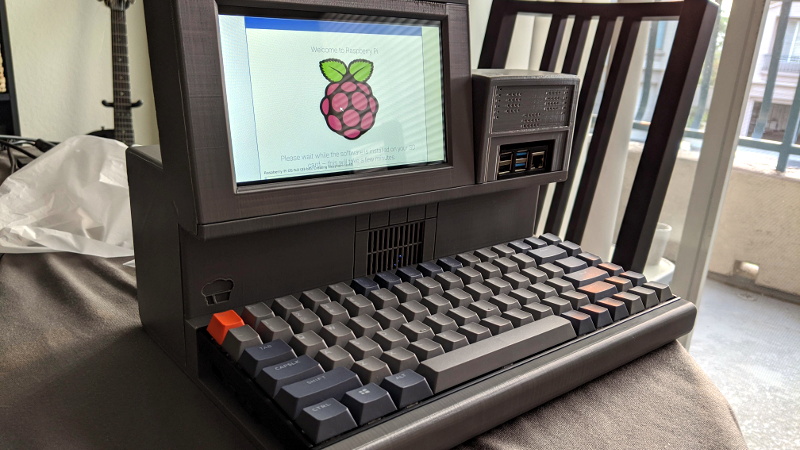Modern computers are incredible feats of engineering, but there are many that still yearn for the simpler times. When keyboards clacked and a desktop computer quite literally dominated the top of your desk. There’s a whole community of folks who scratch that itch by restoring vintage computers, but not everyone has the time, money, or skill for such pursuits. Plus, even the most lovingly cared for Apple II isn’t going to help you watch YouTube.
Those who wish to recreate the look and feel of a vintage computer with modern internals will certainly be interested in the HALWOP by [Maz_Baz]. While its 3D printed case isn’t a replica of any one computer, it does draw inspiration from iconic machines like the Apple Lisa and IBM XT. It’s an amalgamation of design ideas that seemed like a good idea circa 1982 or so, with plenty of 90° angles and air vents to go around.
 Considering the size of the Raspberry Pi 4 that powers the HALWOP, most of the case is just hollow plastic. But of course, the whole idea depends on it being almost comically large. On the plus side, [Maz_Baz] says you can use one of those empty compartments to hold a Anker PowerCore 26800 battery pack. At least in theory that makes it a “luggable” computer, though good luck trying to move it around.
Considering the size of the Raspberry Pi 4 that powers the HALWOP, most of the case is just hollow plastic. But of course, the whole idea depends on it being almost comically large. On the plus side, [Maz_Baz] says you can use one of those empty compartments to hold a Anker PowerCore 26800 battery pack. At least in theory that makes it a “luggable” computer, though good luck trying to move it around.
In addition to the Pi 4 and battery pack, the HALWOP also uses a seven-inch touch LCD and Keychron K2 Bluetooth mechanical keyboard. Since everything is so modular, assembly is about as simple as it gets. Outside of the USB cables that power everything, you just need a long enough ribbon cable to connect the LCD to the Pi.
We know the purists don’t like the idea of a “retro” computer based on the Raspberry Pi, but of course, such projects aren’t about maintaining historical accuracy. They are a way to bridge the gap between modern technology and the unique aesthetics of a bygone era. Designs like the HALWOP allow a new generation to experience a taste of what computing was like in the early days, without giving up the ground that’s been gained in the intervening years.















Macintosh mini but with fpga and working on OS7 (and 4 AA BATTERY) this will be great
Other than the obviously 3d printed parts looking a bit out of place to the style its designed in that is really quite cool, and highly useable.
I think perhaps to avoid having to spend too long on the sanding and filling steps while getting a more genuine look a textured wrap or stippled all over with high build primer type paints to match some of the finishes of the day. Simple relatively cheap and quick for a more old look.
I love all the available space inside – if you like the old styling you can put it to use for just about anything you might want – throw in the SDR for example. I think for me I’d keep the Pi but with a FPGA board or two alongside – for ‘proper’ old hardware emulation, muxing the input/outputs and probably as a ‘secure’ password manager type thing.. Lots of scope with all that space…
I don’t know if you have a 3d printer, but once you start printing, you realise:
“Damn, I made this”
and the layer lines become more pleasant to look at, considering you would probably have no other way of making something so efficiently.
Oh I do, and I spend an inordinate amount of time filling and sanding parts if they are meant to look like ‘real’ parts.
Your right there is nothing wrong with the lines, it just for me doesn’t work with the vintage astetic – nothing from the era looked that way at all.
As Peter says one of the best ways to use a 3D printer for flat surfaces is not to – just use it as a frame around sheet materials. Or even just do the very complex corners and complex geometries and do all the flat stuff with sheet stock.
You could use sheets of plastic for simple shapes instead of 3d printing flat surface then you don’t have those print lines its faster and you leave 3d printer for complicated shapes where either you don’t see lines or sand them by hand.
I like this project it has retro feel and with RasPi4 it has enough power to be daily driver for most people.
I wonder how dual setup MISTER+RasPi would work?